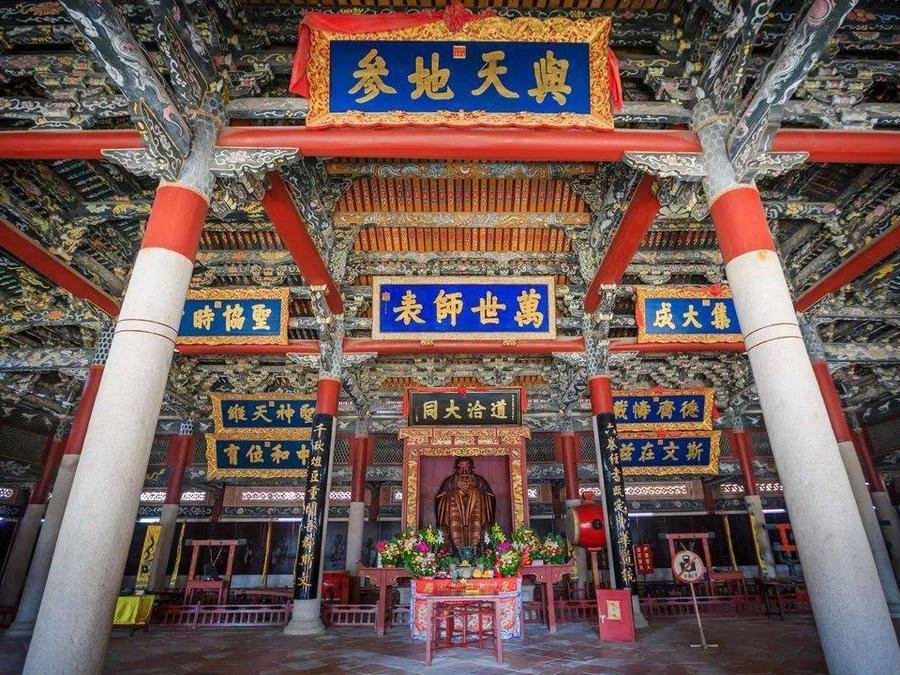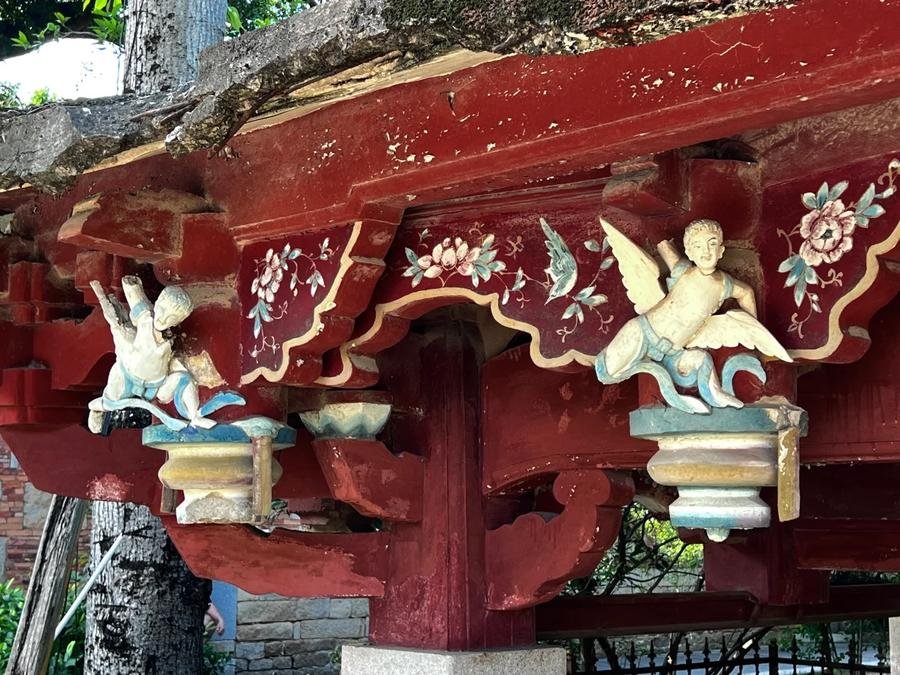The Confucius Temple in Quanzhou, also known as Quanzhou Fu Wenmiao (泉州府文庙), covers an area of over 8,000 square meters. It was originally built during the Tang Kaiyuan Era under the name “Temple of Lu Si Kou.” In the late Tang and Five Dynasties periods, it was renamed “Xuan Sheng Temple.” During the Taiping Xingguo period (976-984) of the Northern Song Dynasty, the temple was relocated to its current site. It underwent significant reconstruction in the seventh year of the Shaoxing reign (1137) of the Southern Song Dynasty, and by the first year of the Jiatai reign (1201), the Lingxing Gate was added, shaping the temple’s current scale. Throughout various dynasties, the temple experienced multiple renovations, with extensive restorations made to the halls, pavilions, courtyards, and ceremonial gates during the Qianlong period of the Qing Dynasty.
Quanzhou Confucius Temple is the largest existing Confucian temple complex in southeastern China, encompassing architectural styles from the Song, Yuan, Ming, and Qing dynasties. The entire complex is oriented north to south, with its main structures aligned along the central axis. Key buildings include the Dacheng Gate, Jinsheng Gate, Yuzhen Gate, East and West Side Halls, and the Dacheng Hall. The foundation stones and platforms date back to the Song Dynasty, while the wooden components were reconstructed during the Qing Dynasty, faithfully preserving the original architectural style.
Table of Contents
- Basic Information
- Location and Transportation
- Highlights of Quanzhou Confucius Temple
- Vlog about Quanzhou Confucius Temple
- Other Attractions in Quanzhou Ancient City
Basic Information
| Estimated Length of Tour | 1 hour |
| Ticket Price | Free |
| Opening Hours | 8.30 – 17.30 |
Location and Transportation
The Confucius Temple is located near Zhongshan Middle Road, Licheng District, Quanzhou City, Fujian Province, China. To get there, you can take bus 4, 6, 14, 19, 24, 25, 26, 33, 41, or 601 and get off at Fuwenmiao Stop (府文庙站).
Highlights of Quanzhou Confucius Temple
Dacheng Hall

Dacheng Hall is the central structure of the Confucius Temple. This grand building features seven bays in width and five bays in depth, supported by 48 stone pillars that uphold a timber frame in the traditional “raising beam” style. The hall’s construction dates back to the early Southern Song Dynasty. Initially, it housed a clay statue of Confucius. In the ninth year of the Jiajing reign (1530) of the Ming Dynasty, the statue was replaced with a wooden tablet inscribed with the title “大成至圣先师孔子 (Great Accomplished Sagely Teacher Confucius),” based on a color-enhanced, enlarged replica of a portrait by the renowned Tang Dynasty artist Wu Daozi.
In front of the hall lies a passageway and a worship courtyard, beyond which is the Pan Pond. Spanning the pond is the Pan Bridge, built in the ninth year of the Zhizheng reign (1349) of the Yuan Dynasty. The bridge, made of stone with a flat beam structure and a central arch, features a surface paved with 72 long granite slabs. Stone railings adorned with carvings of lotus flowers, hibiscus, peonies, and other motifs line the sides of the bridge.
Cultural Relics Exhibition Hall

The Cultural Relics Exhibition Hall within the Confucius Temple is located in Dacheng Hall. At the center stands a statue of Confucius, flanked by portraits of his four principal disciples and twelve wise philosophers. The exhibition showcases various artifacts related to Confucian rituals, including ceremonial musical instruments, dance implements, and ritual vessels. Among these artifacts are six bronze dou vessels, inscribed with significant historical details. One set bears the inscription, “Donated by Jiang Yuanshu, Prefect of Taiwan in the eleventh year of the Qianlong reign, supervised by Jiang Honggao, Gongsheng.” Another set reads, “Cast in May of the sixth year of the Tongzhi reign, by the Provincial Government of Taiwan, supervised by Li Shu of the Educational Administration.” These inscriptions provide valuable material evidence for studying the historical connections between the Quanzhou Confucius Temple and the Confucius Temple in Taiwan.
Quanzhou Historical Figures Memorial Hall

The Quanzhou Historical Figures Memorial Hall is located in the western wing of the Confucius Temple. This hall features exhibits dedicated to 38 renowned cultural figures from various dynasties, including the Tang, Five Dynasties, Song, Yuan, Ming, and Qing. These individuals reflect the rich cultural heritage of Quanzhou, highlighting the city’s significance in fields such as politics, culture, economics, military affairs, overseas trade, and national unity. The exhibits use modern wax sculpture techniques, complete with detailed period costumes, creating lifelike representations of these historical personalities.
Quanzhou Ancient Education Exhibition Hall

The Quanzhou Ancient Education Exhibition Hall is situated in the eastern wing of the Confucius Temple. This exhibition traces the development of education in Quanzhou, starting from the Jin Dynasty when scholars from the Central Plains migrated to Quanzhou, bringing with them the culture of their homeland. As family schools began to flourish, the Song Dynasty saw the establishment of county schools throughout Quanzhou, alongside numerous private academies that sprouted up like mushrooms after rain. The city was celebrated for its educational achievements, earning the nickname “Seaside Zou Lu,” a reference to the cultural heartlands of ancient China.
The exhibition showcases a wealth of photographs and artifacts, vividly illustrating the history and remnants of education in the region. Items on display include inscriptions, textbooks, imperial examination papers, plaques, and couplets, providing a comprehensive glimpse into the educational practices of the time.








